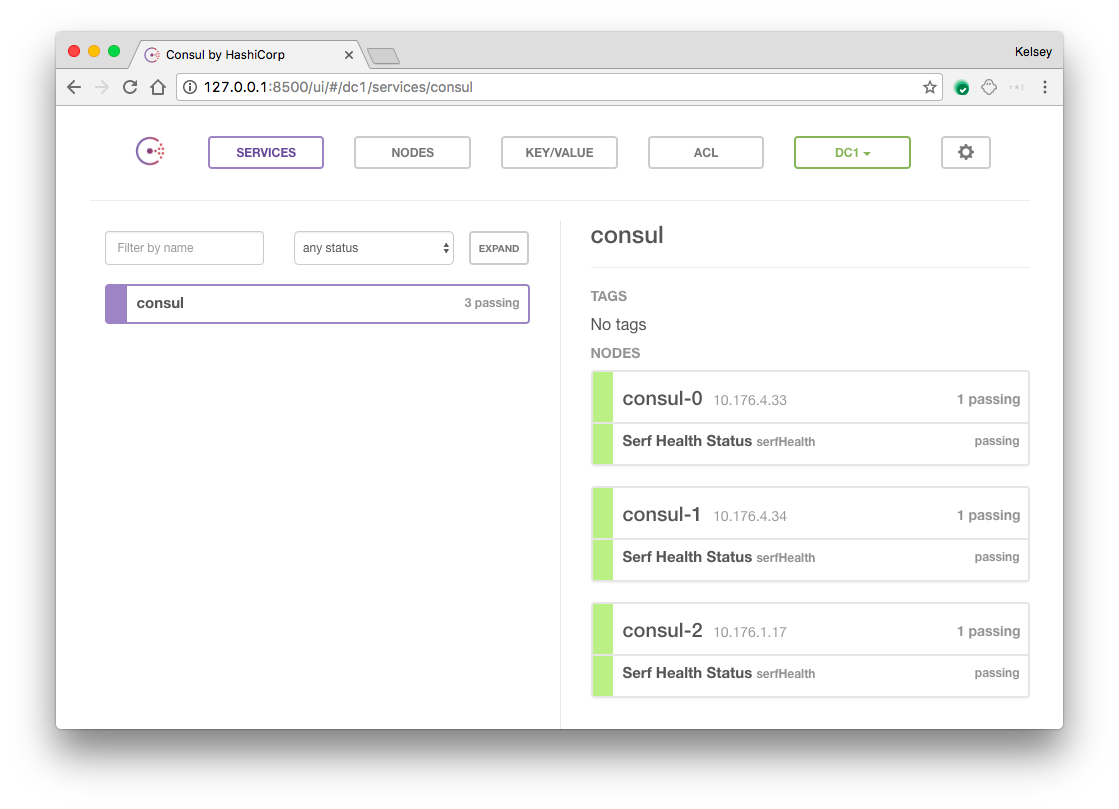This tutorial will walk you through deploying a three (3) node Consul cluster on Kubernetes.
- Three (3) node Consul cluster using a StatefulSet
- Secure communication between Consul members using TLS and encryption keys
This tutorial leverages features available in Kubernetes 1.6.0 and later.
- kubernetes 1.7.x
The following clients must be installed on the machine used to follow this tutorial:
Clone this repo:
git clone https://github.com/kelseyhightower/consul-on-kubernetes.git
Change into the consul-on-kubernetes directory:
cd consul-on-kubernetes
RPC communication between each Consul member will be encrypted using TLS. Initialize a Certificate Authority (CA):
cfssl gencert -initca ca/ca-csr.json | cfssljson -bare ca
Create the Consul TLS certificate and private key:
cfssl gencert \
-ca=ca.pem \
-ca-key=ca-key.pem \
-config=ca/ca-config.json \
-profile=default \
ca/consul-csr.json | cfssljson -bare consul
At this point you should have the following files in the current working directory:
ca-key.pem
ca.pem
consul-key.pem
consul.pem
Gossip communication between Consul members will be encrypted using a shared encryption key. Generate and store an encrypt key:
GOSSIP_ENCRYPTION_KEY=$(consul keygen)
The Consul cluster will be configured using a combination of CLI flags, TLS certificates, and a configuration file, which reference Kubernetes configmaps and secrets.
Store the gossip encryption key and TLS certificates in a Secret:
kubectl create secret generic consul \
--from-literal="gossip-encryption-key=${GOSSIP_ENCRYPTION_KEY}" \
--from-file=ca.pem \
--from-file=consul.pem \
--from-file=consul-key.pem
Store the Consul server configuration file in a ConfigMap:
kubectl create configmap consul --from-file=configs/server.json
Create a headless service to expose each Consul member internally to the cluster:
kubectl create -f services/consul.yaml
Deploy a three (3) node Consul cluster using a StatefulSet:
kubectl create -f statefulsets/consul.yaml
Each Consul member will be created one by one. Verify each member is Running before moving to the next step.
kubectl get pods
NAME READY STATUS RESTARTS AGE
consul-0 1/1 Running 0 50s
consul-1 1/1 Running 0 29s
consul-2 1/1 Running 0 15s
At this point the Consul cluster has been bootstrapped and is ready for operation. To verify things are working correctly, review the logs for one of the cluster members.
kubectl logs consul-0
The consul CLI can also be used to check the health of the cluster. In a new terminal start a port-forward to the consul-0 pod.
kubectl port-forward consul-0 8400:8400
Forwarding from 127.0.0.1:8400 -> 8400
Forwarding from [::1]:8400 -> 8400
Run the consul members command to view the status of each cluster member.
consul members
Node Address Status Type Build Protocol DC
consul-0 10.176.4.30:8301 alive server 0.7.2 2 dc1
consul-1 10.176.4.31:8301 alive server 0.7.2 2 dc1
consul-2 10.176.1.16:8301 alive server 0.7.2 2 dc1
The Consul UI does not support any form of authentication out of the box so it should not be exposed. To access the web UI, start a port-forward session to the consul-0 Pod in a new terminal.
kubectl port-forward consul-0 8500:8500
Visit http://127.0.0.1:8500 in your web browser.
Run the cleanup script to remove the Kubernetes resources created during this tutorial:
bash cleanup
